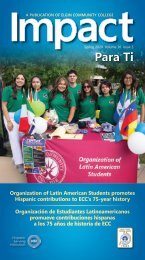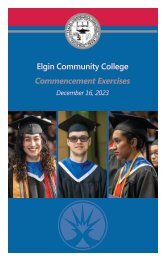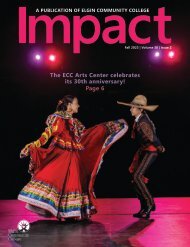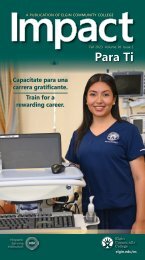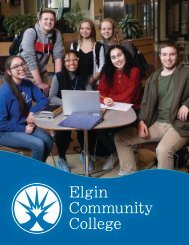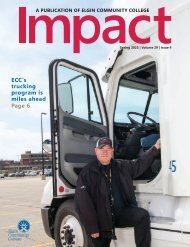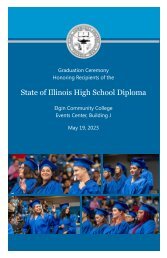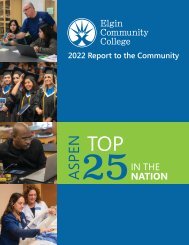ILEA Equity Plan | Elgin Community College (ECC)
There are wide and persistent gaps in college completion rates in Illinois, especially among students of color and low-income students. After an in-depth analysis of our institutional data, Elgin Community College (“ECC” or “the College” or “we” or “our”) has developed an Equity Plan containing annual growth targets for which progress updates will be shared publicly over the next five years. Our Equity Plan reflects the unique characteristics of our institution. For example, ECC is designated as a Hispanic Serving Institution by the US Department of Education, with just over 42% of the students identifying as Latinx or Hispanic. Also, the district served by ECC is widely diverse in terms of income and educational attainment. We will identify the obstacles students face and develop programs and policies that break down unnecessary college graduation barriers. Along with our fellow colleges, in the Partnership for College Completion organization, with this Illinois Equity in Attainment (“ILEA”) plan, we pledge to close the completion gaps by 2025.
There are wide and persistent gaps in college completion rates in Illinois, especially among students of color and low-income students. After an in-depth analysis of our institutional data, Elgin Community College (“ECC” or “the College” or “we” or “our”) has developed an Equity Plan containing annual growth targets for which progress updates will be shared publicly over the next five years. Our Equity Plan reflects the unique characteristics of our institution. For example, ECC is designated as a Hispanic Serving Institution by the US Department of Education, with just over 42% of the students identifying as Latinx or Hispanic. Also, the district served by ECC is widely diverse in terms of income and educational attainment. We will identify the obstacles students face and develop programs and policies that break down unnecessary college graduation barriers. Along with our fellow colleges, in the Partnership for College Completion organization, with this Illinois Equity in Attainment (“ILEA”) plan, we pledge to close the completion gaps by 2025.
You also want an ePaper? Increase the reach of your titles
YUMPU automatically turns print PDFs into web optimized ePapers that Google loves.
to be addressed. In other areas, such as persistence rates, one target population (Latinx<br />
students) has the highest persistence rates of any group while another target population<br />
(Black/African American students) has the lowest persistence rates. Those who receive Pell<br />
persist at higher rates than those students who do not receive Pell.<br />
The obvious implication of the current state is to close the gap with African American students.<br />
However, despite the fact Latinx students demonstrate higher persistence rates than other<br />
races/ethnicities, there is always room for improvement. Our largest population of students<br />
are and therefore, we need to continuously assess and reinvent ways of identifying where<br />
equity gaps may exist beyond the metrics used in the <strong>ILEA</strong> <strong>Plan</strong>. We have to take into account<br />
metrics that reflect our student population and where other gaps may exists such as with our<br />
part-time students (taking 3-8 credits at a time), adult learners, etc.<br />
2B: Past and Present Strategies<br />
For years, <strong>ECC</strong> has incorporated institutional structures to address equity attainment across all<br />
populations as part of our Strategic <strong>Plan</strong>. There have been multiple strategies, both past and<br />
present, which have ranged from a single event, to pilot programs that have become<br />
institutionalized, to complete reorganization of department functions, all in an effort to<br />
contribute to improving completion rates for each target student group. Examples of recent<br />
efforts making a positive difference are: Early <strong>College</strong> Credit/Dual Credit; Student Leaders;<br />
African American Connections; Accelerated Learning Pathways; and Financial Aid<br />
Counselors/Literacy Workshops. Below is a listing of some of the more recent efforts that are<br />
making a positive difference:<br />
Early <strong>College</strong> Credit/Dual Credit<br />
<strong>ECC</strong> offers secondary partners multiple options for high school students to earn college credit<br />
while in high school. Most recently, the college has expanded options for students to enroll in<br />
college courses at their high school building. In addition to in-high school dual credit courses<br />
being delivered, we continue to offer full-time and part-time general education and careertechnical<br />
education (CTE) courses on <strong>ECC</strong> campus.<br />
The Dual Credit Partnerships has grown since becoming an intentional focus. The number of<br />
schools that partner, the number of courses offered, and the number of students participating<br />
increases every year. This translates into a cost savings in tuition and an increase in the number<br />
of credits and even Associate degrees earned. As the Spring 2020 semester ends, we anticipate<br />
celebrating another class of Accelerate <strong>College</strong> (full-time dual credit program) students, 30 in<br />
total, graduating with an associate’s degree prior to their high school graduation. This is up<br />
from 10 students in 2019. The following are some of the highlights of the program:<br />
• 2019-2020<br />
o Estimated tuition saved: $891,705<br />
o Credits earned: 5,923. (This does not include the credits that may be earned upon<br />
completion of courses that are still in session over summer months due to COVID-19.<br />
o Students participated: 620 (103% increase)<br />
19<br />
<strong>ILEA</strong> <strong>Equity</strong> <strong>Plan</strong><br />
Current State







